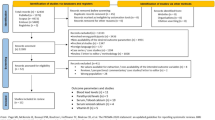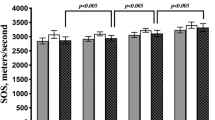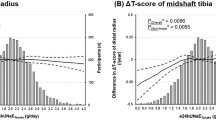Abstract
Bone is one of the target organs for cadmium toxicity. However, few studies have shown the association between cumulative cadmium intake and prevalence of osteoporosis and bone fracture. In the present study, we evaluated the association between cumulative cadmium intake and osteoporosis and risk of fracture in a Chinese population. A total of 790 subjects (488 women and 302 men) living in a control area and two cadmium-polluted areas were included. The cumulative cadmium intake was estimated by a food survey. The bone mineral density was determined by using single-photon absorptiometry. The cumulative cadmium intakes were 0.48, 2.14, and 11.00 g for men, and 0.42, 2.11, and 11.12 g in women in control, and moderately and heavily polluted areas, respectively. In women, the odds ratios (ORs) of subjects with a cadmium intake between 2.21 and 10.63 g and >10.63 g were 1.30 (95% CI: 0.58–2.94) and 2.36 (95% CI: 1.14–5.16), compared with those with a cadmium intake < 0.58 g after adjusting to the confounders for osteoporosis. The ORs of subjects with a cadmium intake >10.63 g were 2.34 (95% CI: 1.23–4.38) for all of the women and 2.62 (95% CI: 1.02–5.58) in women ≥ 60 years old, compared with those with a cadmium intake <10.63 g after adjusting to the confounders for bone fractures. In men, similar trends were observed, but no statistical significance was found. In addition, those subjects with renal tubular dysfunction showed high risk of bone fracture. Our results indicate that a high level of cumulative cadmium intake is associated with an increased rate of osteoporosis and fractures among women.
This is a preview of subscription content, access via your institution
Access options
Subscribe to this journal
Receive 6 print issues and online access
$259.00 per year
only $43.17 per issue
Buy this article
- Purchase on Springer Link
- Instant access to full article PDF
Prices may be subject to local taxes which are calculated during checkout

Similar content being viewed by others
References
WHO/ICPS. Cadmium. Environmental Health Criteria Document. 1992;134:1–280.
Staessen JA, Roels HA, Emelianov D, Kuznetsova T, Thijs L, Vangronsveld J, et al. Environmental exposure to cadmium, forearm bone density, and risk of fractures: prospective population study. Lancet. 1999;353:1140–4.
Åkesson A, Bjellerup P, Lundh T, Lidfeldt J, Nerbrand C, Samsioe G, et al. Cadmium-induced effects on bone in a population-based study of women. Environ Health Perspect. 2006;114:830–4.
Chen X, Zhu G, Jin T, Gu S. Effects of cadmium on forearm bone density after reduction of exposure for 10 years in a Chinese population. Environ Int. 2009;35:1164–8.
Akesson A, Barregard L, Bergdahl IA, Nordberg GF, Nordberg M, Skerfving S. Non-renal effects and the risk assessment of environmental cadmium exposure. Environ Health Perspect. 2014;122:431–8.
Wallin M, Barregard L, Sallsten G, Lundh T, Karlsson MK, Lorentzon M, et al. Low-level cadmium exposure is associated with decreased bone mineral density and increased risk of incident fractures in elderly men: the MrOS Sweden study. J Bone Miner Res. 2016;31:732–41.
Lv Y, Wang P, Huang R, Liang X, Wang P, Tan J, et al. Cadmium exposure and osteoporosis: a population-based study and benchmark dose estimation in southern China. J Bone Miner Res. 2017;32:1990–2000.
Eom SY, Seo MN, Lee YS, Park KS, Hong YS, Sohn SJ, et al. Low-level environmental cadmium exposure induces kidney tubule damage in the general population of Korean adults. Arch Environ Contam Toxicol. 2017;73:401–9.
Pollack AZ, Mumford SL, Wactawski-Wende J, Yeung E, Mendola P, Mattison DR, et al. Bone mineral density and blood metals in premenopausal women. Environ Res. 2013;120:76–81.
Moberg L, Nilsson PM, Samsioe G, Sallsten G, Barregard L, Engström G, et al. Increased blood cadmium levels were not associated with increased fracture risk but with increased total mortality in women: the Malmö Diet and Cancer Study. Osteoporos Int. 2017;28:2401–8.
Engström A, Michaëlsson K, Vahter M, Julin B, Wolk A, Åkesson A. Associations between dietary cadmium exposure and bone mineral density and risk of osteoporosis and fractures among women. Bone. 2012;50:1372–8.
Thomas LD, Michaëlsson K, Julin B, Wolk A, Åkesson A. Dietary cadmium exposure and fracture incidence among men: a population-based prospective cohort study. J Bone Miner Res. 2011;26:1601–8.
Puerto-Parejo LM, Aliaga I, Canal-Macias ML, Leal-Hernandez O, Roncero-Martín R, Rico-Martín S, et al. Evaluation of the dietary intake of cadmium, lead and mercury and its relationship with bone health among postmenopausal women in Spain. Int J Environ Res Public Health. 2017;14:564.
He P, Lu Y, Liang Y, Chen B, Wu M, Li S, et al. Exposure assessment of dietary cadmium:findings from Shanghainese over 40 years, China. BMC Public Health. 2013;13:590.
Hu Y, Cheng H, Tao S. The challenges and solutions for cadmium-contaminated rice in China: a critical review. Environ Int. 2016;92-93:515–32.
Jin T, Nordberg M, Frech W, Dumont X, Bernard A, Ye T, et al. Cadmium biomonitoring and renal dysfunction among a population environmentally exposed to cadmium from smelting in China. Biometals. 2002;15:397–410.
Wang H, Zhu G, Shi Y, Weng S, Jin T, Kong Q, et al. Influence of environmental cadmium exposure on forearm bone density. J Bone Miner Res. 2003;18:553–60.
Jin T, Nordberg GF, Wu X, Ye T, Kong Q, Wang Z, et al. Urinary N-acetyl-β-D-glucosaminidase isoenzymes as biomarker of renal dysfunction caused by cadmium in a general population. Environ Res Sect A. 1999;81:167–73.
Liang Y, Lei L, Nilsson J, Li H, Nordberg M, Bernard A, et al. Renal function after reduction in cadmium exposure: an 8-year follow-up of residents in cadmium-polluted areas. Environ Health Perspect. 2012;120:223–8.
Cai S, Yue L, Jin T, Nordberg GF. Renal dysfunction from cadmium contamination of irrigation water: dose-response analysis in a Chinese population. Bull World Health Organ. 1998;76:153–9.
Kubo K, Nogawa K, Kido T, Nishijo M, Nakagawa H, Suwazono Y. Estimation of benchmark dose of lifetime cadmium intake for adverse renal effects using hybrid approach in inhabitants of an environmentally exposed river basin in Japan. Risk Anal. 2017;37:20–26.
Tucker SM, Boyd PJ, Thompson AE, Price RG. Automated assay of N-acetyl-beta-glucosaminidase in normal and pathological human urine. Clin Chim Acta. 1975;62:333–9.
Inaba T, Kobayashi E, Suwazono Y, Uetani M, Oishi M, Nakagawa H, et al. Estimation of cumulative cadmium intake causing Itai-itai disease. Toxicol Lett. 2005;159:192–201.
Berglund M, Åkesson A, Nermell B, Vahter M. Intestinal absorption of dietary cadmium in women depends on body iron stores and fiber intake. Environ Health Perspect. 1994;102:1058–66.
Weaver CM, Martin BR, Story JA, Hutchinson I, Sanders L. Novel fibers increase bone calcium content and strength beyond efficiency of large intestine fermentation. J Agric Food Chem. 2010;58:8952–7.
Cai S, Yue L, Shang Q, Nordberg GF. Cadmium exposure among residents in an area contaminated by irrigation water in China. Bull World Health Organ. 1995;73:359–67.
Vahter M, Berglund M, Åkesson A, Lidén C. Metals and women’s health. Environ Res. 2002;88:145–55.
Comelekoglu U, Yalin S, Bagis S, Ogenler O, Sahin NO.YildizA, et al. Low-exposure cadmium is more toxic on osteoporotic rat femoral bone: mechanical, biochemical, and histopathological evaluation. Ecotoxicol Environ Saf. 2007;66:267–71.
Jin T, Nordberg G, Ye T, Bo M, Wang H, Zhu G, et al. Osteoporosis and renal dysfunction in a general population exposed to cadmium in China. Environ Res. 2004;96:353–9.
Horiguchi H, Oguma E, Sasaki S, Miyamoto K, Ikeda Y, Machida M, et al. Environmental exposure to cadmium at a level insufficient to induce renal tubular dysfunction does not affect bone density among female Japanese farmers. Environ Res. 2005;97:83–92.
Chen X, Zhu G, Jin T, Lei L, Liang Y. Bone mineral density is related with previous renal dysfunction caused by cadmium exposure. Environ Toxicol Pharmacol. 2011;32:46–53.
Berglund M, Akesson A, Bjellerup P, Vahter M. Metal-bone interactions. Toxicol Lett. 2000;112-113:219–25.
Iwami K, Moriyama T. Comparative effect of cadmium on osteoblastic cells and osteoclastic cells. Arch Toxicol. 1993;67:352–7.
Chen X, Zhu G, Gu S, Jin T, Shao C. Effects of cadmium on osteoblasts and osteoclasts in vitro. Environ Toxicol Pharmacol. 2009;28:232–6.
Chen X, Wang G, Li X, Gan C, Zhu G, Jin T, et al. Environmental level of cadmium exposure stimulates osteoclasts formation in male rats. Food Chem Toxicol. 2013;60:530–5.
Brzóska MM, Majewska K, Moniuszko-Jakoniuk J. Bone mineral density, chemical composition and biomechanical properties of the tibia of female rats exposed to cadmium since weaning up to skeletal maturity. Food Chem Toxicol. 2005;43:1507–19.
Akerstrom M, Barregard L, Lundh T, Sallsten G. Variability of urinary cadmium excretion in spot urine samples, first morning voids, and 24 h urine in a healthy non-smoking population: implications for study design. J Expo Sci Environ Epidemiol. 2014;24:171–9.
Hays SM, Aylward LL, Blount BC. Variation in urinary flow rates according to demographic characteristics and body mass index in NHANES: potential confounding of associations between health outcomes and urinary biomarker concentrations. Environ Health Perspect. 2015;123:293–300.
Chaumont A, Voisin C, Deumer G, Haufroid V, Annesi-Maesano I, Roels H, et al. Associations of urinary cadmium with age and urinary proteins: further evidence of physiological variations unrelated to metal accumulation and toxicity. Environ Health Perspect. 2013;121:1047–53.
Julin B, Vahter M, Amzal B, Wolk A, Berglund M, Akesson A. Relation between dietary cadmium intake and biomarkers of cadmium exposure in premenopausal women accounting for body iron stores. Environ Health. 2011;10:105.
Ikeda M, Shimbo S, Watanabe T, Yamagami T. Correlation among cadmium levels in river sediment, in rice, in daily foods and in urine of residents in 11 prefectures in Japan. Int Arch Occup Environ Health. 2006;79:365–70.
Quraishi SM, Adams SV, Shafer M, Meliker JR, Li W, Luo J, et al. Urinary cadmium and estimated dietary cadmium in the Women’s Health Initiative. J Expo Sci Environ Epidemiol. 2016;26:303–8.
Acknowledgements
This study was funded by the National Natural Science foundation of China (No. 81773460, 81102148), Natural Science Foundation of Jiangsu Province (no. BK20161609), and the Science and Technology Commission of Shanghai Municipality (14DZ2260200, the project of Shanghai Key Laboratory of Kidney and Blood Purification).
Author information
Authors and Affiliations
Corresponding authors
Ethics declarations
Conflict of interest
The authors declare that they have no conflict of interest.
Rights and permissions
About this article
Cite this article
Chen, X., Wang, Z., Zhu, G. et al. The association between cumulative cadmium intake and osteoporosis and risk of fracture in a Chinese population. J Expo Sci Environ Epidemiol 29, 435–443 (2019). https://doi.org/10.1038/s41370-018-0057-6
Received:
Revised:
Accepted:
Published:
Issue Date:
DOI: https://doi.org/10.1038/s41370-018-0057-6
Key words
This article is cited by
-
Assessing Aspects of Cadmium Supply, Recycling and Environmental Pollution with Respect to Future Photovoltaic Technology Demands and Envionmental Policy Goals
Water, Air, & Soil Pollution (2024)
-
Collecting data on fractures: a review of epidemiological studies on orthopaedic traumatology and the Chinese experience in large volume databases
International Orthopaedics (2022)
-
Serum heavy metals of passive smoker females and its correlation to bone biomarkers and risk of osteoporosis
Environmental Science and Pollution Research (2022)
-
Protective Effects of Astilbin Against Cadmium-Induced Apoptosis in Chicken Kidneys via Endoplasmic Reticulum Stress Signaling Pathway
Biological Trace Element Research (2022)
-
Blood lead and cadmium levels are negatively associated with bone mineral density in young female adults
Archives of Public Health (2021)



